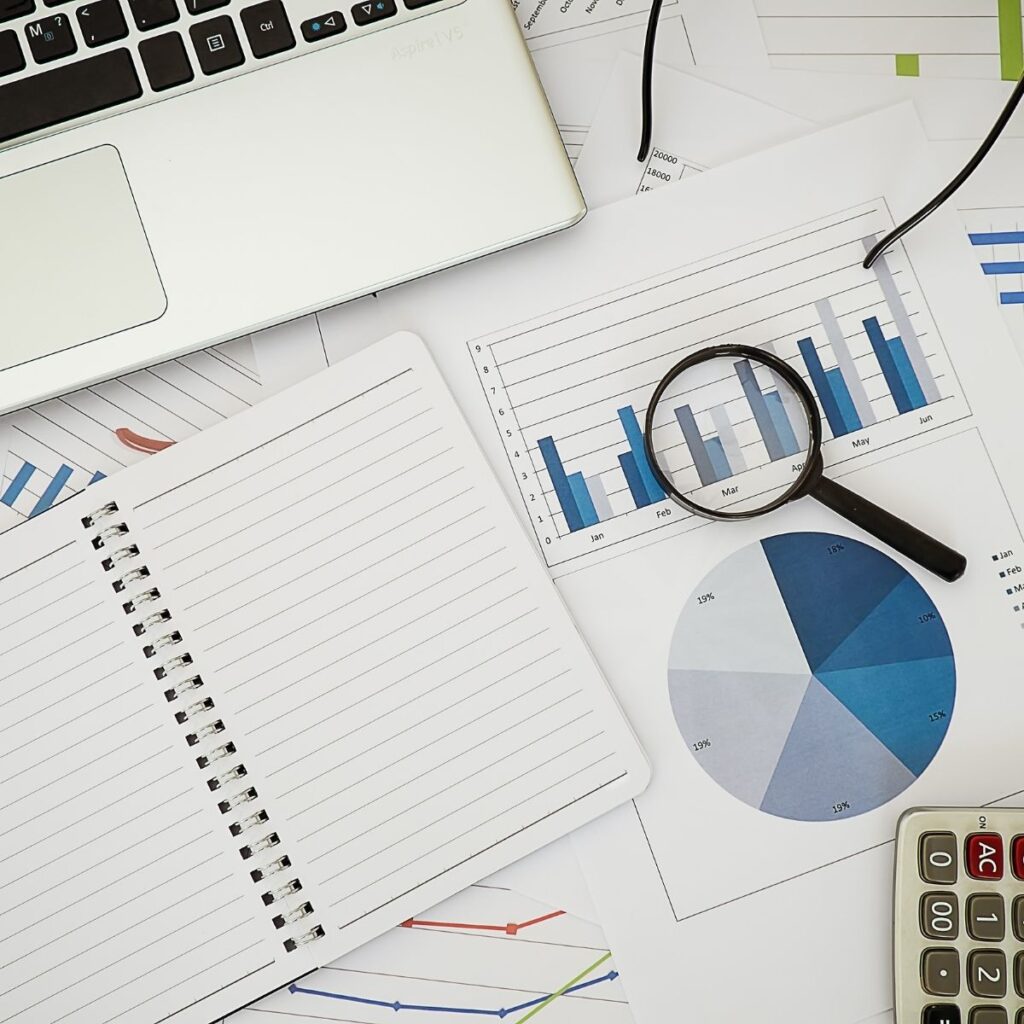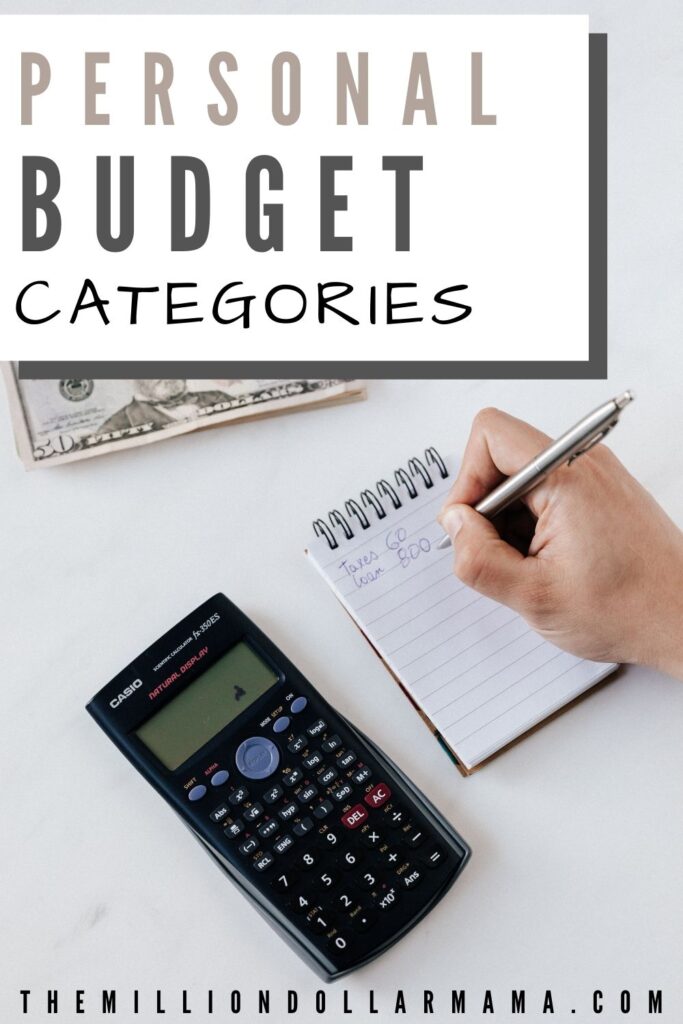Personal budget categories are essential in order to have a complete understanding of how much money you are spending. Personal budget categories are usually made up of the following: fixed expenses, variable expenses, savings goals, debt repayment goals, retirement savings, etc.

Categories for your personal budget can be used for any type of goal you may have! In addition, these budget categories allow you to analyze areas where your money is going and make changes accordingly.
Having good personal budget categories is an easy way to stay on track with your finances and reach all of your financial goals.
Related: The Key to Budget Cutting
Categories in a Personal Budget
The categories in your own personal budget will depend upon your financial needs and goals. However, typical personal budgets are made up of the following categories:
Insurance – it is suggested to spend no more than 15% of your total take-home income in this category each month.
Medical – it is suggested to spend no more than 10% of your total take-home income in this category each month.
Saving, Investing, & Debt Payments – it is suggested to save no more than 20% of your total take-home income in this category each month when first starting out**. However, if you can afford to save or invest more money, you definitely should!
**This is only when you’re first starting out. I HIGHLY recommend boosting your saving category up to 40%+ as soon as you are able.
Personal Spending – it is suggested to spend no more than 5% of your total take-home income in this category each month.

Housing – it is suggested to spend no more than 25% of your total take-home income in this category each month.
Transportation – it is suggested to spend no more than 10% of your total take-home income in this category each month.
Food – it is suggested to spend no more than 10% of your total take-home income in this category each month.
Utilities – it is suggested to spend no more than 5% of your total take-home income in this category each month.
The 7 Categories of a Budget
There are actually a few different types of personal budgets that you can adapt to your own household. You will just need to research and even try out each one in order to find out what works best for your own personal budget.
The following seven types of budgets work for many different people and make work great for you as well:
The Anti Budget – if you tend to be frugal and not spend much money, this may be a great budget for you. With this budget, you just set aside a certain percentage of your income each month and spend the rest without tracking. This is actually the kind of budget I use as I am extremely cognizant over my spending and do track it every month.
The 50/30/20 Budget – with this budget you simply spend 50% on needs, 30% on wants, and save 20% of your take-home income each month. I don’t love this type of budget when you’re trying to reach financial freedom as 30% on wants is too high.
The Zero Based Budget – the zero-based budget is when you take the amount of money that you earn each month and allocate all of your money to each budget category until you reach $0. The cash envelope system is a great example of this.
The Spending Ceiling – with this budget, you place a cap on your amount of spending. This allows you to only have to track one number rather than several.
The No Budget Budget – the no-budget budget is great for those who don’t really need a budget and can spend below their means without a structured budget.
The Spending First Budget – this type of budget is great for when you know your spending habits tend to fall below what you earn. You just need to plan your spending each month and save whatever is leftover.
The Savings First Budget – the savings first budget is the opposite of the spending first budget. You just need to make sure to pay yourself first. You can combine this with any of the above really. I ALWAYS recommend paying yourself first in any situation.

Personal Budget Categories
There comes a time in life when every person has to take control of their own personal finances. This means figuring out what they want from life and then making it happen by setting realistic budgets that will enable them to budget and save money for goals.
Personal budget categories allow people to keep track of their spending and saving on a monthly basis, adjust the amount that they spend/save accordingly, and save more than ever!
Variable Budget Categories
Variable personal budget categories include expenses such as groceries, gasoline, entertainment activities, etc. Variable expenses are those that tend to change from month to month based on your needs.
When setting up variable expense budgets, it is important to set limits, so you do not go overboard. Depending on how much you spend each month, divide that number by the number of months in a year to have a general idea of what your monthly budget should be. This will help you to stay within your means and avoid going over.
Fixed Budget Categories
Fixed personal budget categories include expenses such as rent or mortgage, utilities (electricity, gas, water), insurance payments (auto insurance, health insurance), etc.
Fixed expenses are those that tend to remain constant each month. An example of a fixed budget category is your monthly mortgage.
This expense will remain the same each month, so it makes it easier to budget as you know exactly how much that expense will be each month.
Budget Categories for Savings
Personal budget categories for savings include money that is set aside for saving or investing. These savings categories for your personal budget may include:
Retirement Savings
Retirement savings are typically organized into retirement funds. Some common types of personal budget categories for retirement include Traditional IRA, Roth IRA, or 401(k).
These budget categories for retirement are meant to help you accumulate money over time. Savings categories of this nature are set up by setting a specific amount that will be saved each month towards future savings goals.
Emergency Fund
Suppose there is an unexpected car accident or some other type of catastrophe that costs thousands of dollars to fix. In that case, you will have money saved up in your account, ready to handle the situation by adding money to an emergency fund each month.

How to Build Your Budget Categories List
One great way to get started with your budget categories list is to split your budget between household and personal spending categories.
Build your categories in a way that works best for you. You want your budget to be easy to stick to and not feel overwhelming. You want a budget that will allow you to be consistent with tracking your expenses each month.
You may want to read one of these amazing budgeting books and try one of these budget planners too.
Here are 50 categories ideas to help you to get started with building your budget:
Household Budget Categories
- utilities – cable, internet, trash, water & sewer, electricity, gas, cell
- lawn care
- gardening supplies
- home repairs & appliance replacement
- tools & supplies
- mortgage/rent
- HOA dues
- property taxes
- home insurance
Budget Categories for Personal Spending
- exercise
- self-care activities
- hobby stuff
- side hustle supplies & costs
- fun money
- makeup
- hair products
- hair cuts
- vitamins & supplements
- clothing & shoes

Budget Categories for Savings
- sinking funds – vacations, home repairs, holidays, etc.
- college fund for kids
- charitable giving
- retirement contributions
- emergency fund
Budget Categories for Paying Down Debt
- HELOC repayment
- credit card debt
- car debt
- minimum payments
- fees & charges (i.e., late fee, overdrafts, etc.)
- personal loan debt
- student payments

Budget Categories for Medical Expenses
- co-pays
- first aid supplies
- medical equipment
- therapy
- life insurance
- health insurance premiums
- health insurance deductible
- prescriptions
- eye care & glasses
- dental & orthodontics
Budget Categories for Transportation
- regular maintenance – oil changes, services, new tires, etc
- parking fees
- car registration
- DMV fees
- DEQ fees
- Hobby transportation (i.e., bike costs, etc.)
- gas
- car payments
- car insurance
- toll road fees
- public transportation costs & passes
- car repairs

Other Miscellaneous Budget Categories
A lot of these categories can be eliminated if your goal is financial freedom. Once you’ve categorized all your spending, start in these miscellaneous categories first to start eliminating items.
- lessons & clubs
- summer camps & programs
- fees & registrations
- subscription boxes
- babysitters
- fun stuff – toys, art supplies, hobby stuff, books
- Holiday stuff – Easter outfit, Halloween costumes, Christmas pictures with Santa, etc.
- clothes & shoes
- haircuts
- school supplies
- school lunches
- daycare
- professional fees & licensing
- after-hours events
- work equipment, tools & supplies
- uniform or professional clothing
- dry cleaning
- lunches & snacks
- coffee
- transportation & parking fees
- meal kits
- subscriptions – Netflix, Disney+, Amazon Prime, etc.
- household supplies – cleaners, soap, paper goods, etc.
- tax prep & legal fees
- basic groceries
- splurge groceries
- restaurants & fast food
- pet food & vitamins
- toys, cages, etc
- grooming
- purchase price of pet
- veterinary care
- lessons & training
- licenses
- birthday presents
- graduations
- anniversary presents
- holiday presents – Christmas, Easter baskets, Valentine’s Day treats, Halloween candy
- weekend getaways
- day trips – entry fees
- concerts & festivals
- airfare
- trip insurance
- road trips – gas, snacks & supplies
- family reunions
- holiday BBQ’s
- Christmas events
- spring break vacations
- summer vacations
- winter break vacations
How to Deal With Irregular Expenses
Some expenses come up irregularly and need to be accounted for. If you have a yearly or semi-yearly expense, such as an annual home insurance policy, divide the cost by 12 and add it in monthly.
Likewise, if something happens every three months like your oil change schedule, divide the cost by three and add it in monthly.
Why Personal Budget Categories are Important
Personal budget categories are essential in order to have a complete understanding of how much money you are spending. These personal budget categories can be used for any type of goal you may have.
Having specific categories for your personal budget allows you to analyze areas where your money is going and make changes accordingly. Having these budget categories is an easy way to stay on track with your finances and reach all of your financial goals.
Do you keep a budget? What categories do you use to crate it and track your expenses? Comment below!
Hi I’m Ana. I’m all about trying to live the best life you can. This blog is all about working to become physically healthy, mentally healthy and financially free! There lots of DIY tips, personal finance tips and just general tips on how to live the best life.


Leave a Reply